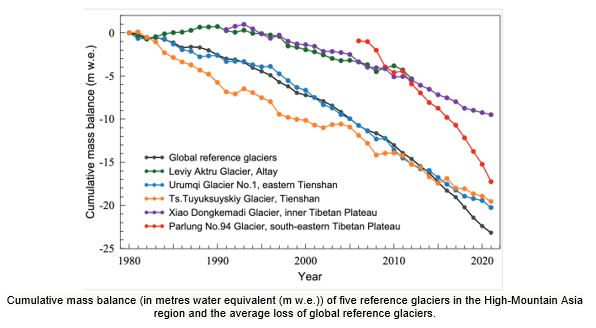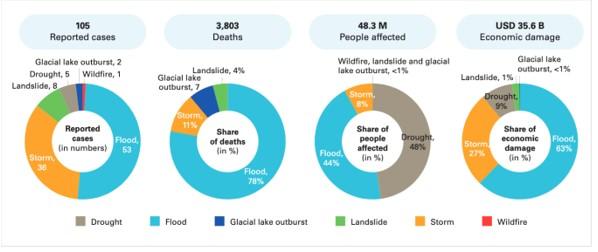Economic losses from extreme weather rocket in Asia
Economic losses from drought, floods and landslides have rocketed in Asia. In 2021 alone, weather and water-related hazards caused total damage of US$ 35.6 billion, affecting nearly 50 million people, according to a new report from the World Meteorological Organization (WMO).
Sharm-el-Sheikh, Egypt, 14 November 2022 - Economic losses from drought, floods and landslides have rocketed in Asia. In 2021 alone, weather and water-related hazards caused total damage of US$ 35.6 billion, affecting nearly 50 million people, according to a new report from the World Meteorological Organization (WMO).
The State of the Climate in Asia 2021 report highlighted how climate change impacts are wreaking an ever-increasing human, financial and environmental toll, worsening food insecurity and poverty and holding back sustainable development.
The report also painted a worrying scenario for future water stress. High Mountain Asia, including the Himalayas and the Tibetan Plateau, contains the largest volume of ice outside of the polar region, with approximately an area of 100,000 km2 of glacier coverage. The rate of glacier retreat is accelerating and many glaciers suffered from intense mass losses as the result of exceptionally warm and dry conditions in 2021. These so-called water towers of the world are vital for freshwater supplies for the most densely populated part of the planet and so glacier retreat has major implications for future generations.

Water-related extremes are the most important hazard in Asia.
“The climate indicators and extreme events shown this report and expected increase in precipitation over much of Asia in the future shows just how vital it is to strengthen early warning systems,” said WMO Secretary-General Prof. Petteri Taalas. “The UN Early Warnings for All programme will help protect people from more frequent and intense extreme weather – and there are major gaps to be filled in Asia.”
The report, which was produced jointly with the UN Economic and Social Commission for Asia and the Pacific (ESCAP), was presented during the UN climate change negotiations, COP27, in Sharm El Sheikh, Egypt.
It shows how, compared to the average in the past 20 years, economic losses are on the rise for most types of disasters. Economic damage from drought has increased by 63 percent from flood has increased by 23 percent, and from landslides has increased by 147 percent compared to the 2001-2020 average.
In 2021, there were a total of more than 100 natural hazard events in Asia, of which 80 percent were flood and storm events. These resulted in almost 4,000 fatalities, about 80 percent caused by flooding. Overall, 48.3 million people were directly affected by these hazards, causing total economic damage of US$ 35.6 billion. While floods caused the highest fatalities and economic damage, drought in the region affected the highest number of people, according to the report. Sand and dust storms were also a major problem.
In 2021, flooding caused the highest economic losses in China (US$ 18.4 billion), followed by India (US$ 3.2 billion), and Thailand (US$ 0.6 billion). Storms also caused significant economic damage, especially in India (US$ 4.4 billion), China (US$ 3.0 billion), and Japan (US$ 2 billion).
“Given that floods and tropical cyclones in the region account for the highest economic losses, investment in adaptation must be directed towards prioritizing anticipatory action and preparedness,” said Armida Salsiah Alisjahbana UN Under-Secretary-General and Executive Secretary of ESCAP.
“Notwithstanding the progress in establishing early warning systems, further strengthening is needed as climate change intensifies. Similarly, new infrastructure needs to be made more resilient, alongside improvements in water resources management and dryland agricultural crop production, while nature-based solutions bring durable and wide-ranging benefits.”
The Economic and Social Commission for Asia and the Pacific (ESCAP) Asia-Pacific Disaster Reports 2021 and 2022 estimate that in Asia, the annual investment in adaptation would need to be highest for China, at US$ 188.8 billion, followed by India at US$ 46.3 billion, and Japan at US$ 26.5 billion. As a percentage of the country’s GDP, the highest cost is estimated for Nepal, at 1.9%, followed by Cambodia at 1.8%, and India at 1.7%.
The majority of Asian countries have prioritized adaptation in their climate action plans, with the majority highlighting water, agriculture and food security, ecosystem and biodiversity, and health as their top priority areas.
Top adaptation priorities informed by the risk landscape and with high investment cost-benefits, are:
- strengthening early warning systems and building resilient infrastructure
- making water resources management more resilient,
- improving dryland agriculture crop production
- implementing nature-based solutions.
Investing in these policy actions will catalyze progress in sustainable development and climate action.

|
| Overview of 2021 disasters in Asia. Source: ESCAP calculations based on EM-DAT, accessed on 30 April 2022 |
Other highlights
The mean temperature over Asia was cooler than the warmest previous year 2020, but it was still between the 5th and 7th warmest year on record at an estimated 0.86 °C above the 1981-2010 average. The continent is warming faster than the global average. In the two recent sub-periods (1961–1990 and 1991–2020), the warming trend in Asia, which is the continent with the largest land mass extending to the polar region, have exceeded the global mean value.
The ocean: the Kuroshio current system (on the west side of the North Pacific Ocean basin), the Arabian Sea, and the southern Barents, Kara Sea and the southeastern Laptev Sea in the Arctic, are warming about three times faster than the global average. The Barents Sea is identified as a climate change hotspot. The rates of sea-level rise in Oceans surrounding Asia are slightly faster than the global mean.
Precipitation: In 2021, West Asia, including in particular Iran, Iraq, Afghanistan and the Arabian Peninsula, suffered drought. There was abnormally high annual precipitation in South and Southeast Asia, eastern China and the Western Siberian Plain. The number of days of snow coverage was record low in the polar region of Asia.
Food security: Asia is one of the regions with the highest number of people facing severe food insecurity. According to the Global Report on Food Crisis by World Food Programme, in 2021 three out of the top ten countries with the highest number of people in crisis or worse were in Asia. Climate change induced extreme weather events exacerbate this vulnerability.
In Afghanistan, prolonged drought in addition to the economic struggle has brought 47% of the population to high levels of acute food insecurity. Reduced rainfall during the wet season and less snowpack development affected water availability for the crops in 2021, which limited availability of food in comparison to other years.
The World Meteorological Organization is the United Nations System’s authoritative voice
on Weather, Climate and Water
For further information contact:
Clare Nullis, WMO media officer, cnullis wmo [dot] int (cnullis[at]wmo[dot]int). Tel 41-79-7091397
wmo [dot] int (cnullis[at]wmo[dot]int). Tel 41-79-7091397

